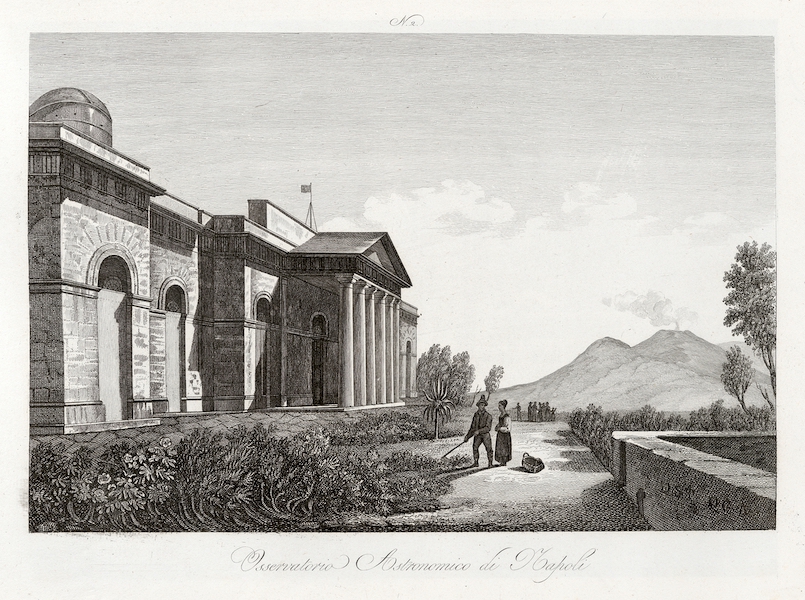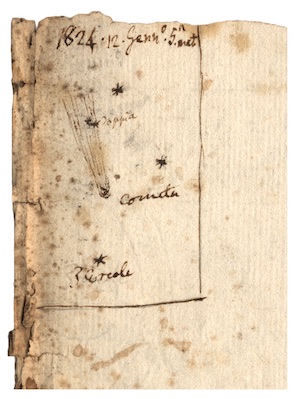Hall of the Columns
Astronomical Observatory of Capodimonte
10 June - 22 July 2021
Iconographic exhibition on the development of astronomy in Naples during the reign of the Bourbon dynasty
curated by Mauro Gargano, Emilia Olostro Cirella, Marcella Marconi, Liana De Filippis.
Exhibition of volumes, prints, photographs and documents of the time, on the bicentenary of the visit of King Ferdinand of Bourbon on the Capodimonte terrace overlooking the city and the Gulf of Naples and on the 275th anniversary of the birth of Giuseppe Piazzi, founder of the Observatory of Palermo, discoverer of Ceres, the first nineteenth-century planet and the second modern celestial body after Herschel's "Georgium Sidus", and author of a monumental star catalog.

The exhibition highlights the roles played by the Bourbon dynasty, as protector of the sciences, and by Giuseppe Piazzi, as promoter of astronomical studies in the kingdoms of Naples and Sicily since the last decade of the eighteenth century, and presents the activities and scientific achievements obtained by the astronomers of Capodimonte in the first half of the nineteenth century.
Upon entering the Hall of the Columns, the visitor will be greeted by King Ferdinando, who discreetly and silently watches over the scientific activities of the Observatory and from the bust of Giuseppe Piazzi. The bas-relief by sculptor Claudio Monti depicts the
king of the Two Sicilies crowned by Urania, muse of astronomy, under the pleased gaze of Ceres, goddess of harvest and protector of Sicily.

The exhibition consists of four sections that retrace the development of astronomy in Naples in the eighteenth century under the renewing impulse of Carlo di Borbone, that present the first scientific research done in Capodimonte by Carlo Brioschi and that illustrate the astronomical and literary successes of Ernesto Capocci, observer of comets and sunspots, and Annibale de Gasparis, discoverer of nine asteroids that earned him commendations both at home and abroad. The itinerary ends with the section dedicated to astronomy that inspires science enthusiasts, writers and artists in a period of intense cultural fervor and new and great social and political transformations.
Among the works of Pietro and Niccolò Di Martino, Giovanni Maria della Torre, Piazzi, Brioschi and Giuseppe Poli, the selenographic table by Niccolò Gianpriamo and the double paraselene observed in Piedimonte Matese by a Swiss textile industrialist make a fine show. The engraving of the winged chariot ruled by Dante Alighieri traveling to the Moon, taken from the volume Estasi e rapimento sopra la luna, is a tribute to the "Divine Poet" for the 700th anniversary of his death together with the book by Capocci Illustrazioni cosmografiche della Divina Commedia, the first example of a popular text in which Capocci analyzes Dante's verses dealing with astronomy.
Finally, two unpublished manuscripts by Giuseppina Guacci, a Neapolitan writer and wife of the astronomer Antonio Nobile: Dialoghi tra Arturo e la mamma and Lettere di Michelangelo al padre, the latter published for the first time on the occasion of this exhibition, in which the poetess from Capodimonte talks with her son, who lived only two days, on astronomical themes or have the young astronomy student tell about the life and scientific activities carried out on the Miradois hill.
The initiative is part of the activities of the Campania Teatro festival 2021
Access to the exhibition is by reservation only and in compliance with the regulations for the health emergency.
To book https://stelle-di-re.eventbrite.it
To visit the virtual exhibition: https://www.stelle-di-re.inaf.it